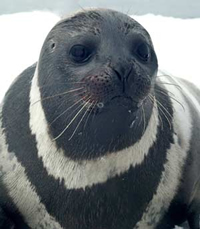
 |
|
|
December 23, 2008
NOAA Determines Ribbon Seals Should Not be Listed as EndangeredFrom a NOAA press release:NOAA today announced that ribbon seals are not in current danger of extinction or likely to become endangered in the foreseeable future, and should not be listed under the Endangered Species Act. 
On Dec. 20, 2007, the Center for Biological Diversity petitioned NOAA's Fisheries Service to list the ribbon seal under the Endangered Species Act. The petition said the seal faced extinction by the end of the century due to rapid melting of sea ice resulting from global warming. Sea-ice in the Bering Sea, Sea of Okhotsk, Sea of Japan, Chukchi Sea, and Beaufort Sea is the seal's primary habitat. Today's announcement is the result of NOAA's review of this petition and the condition of the ribbon seal. "Our scientists have reviewed climate models that project that annual ice, which is critical for ribbon seal reproduction, molting and resting, will continue to form each winter in the Bering Sea and the Sea of Okhotsk where the majority of ribbon seals are located," said Jim Balsiger, NOAA's acting assistant administrator for fisheries. From March to June, ribbon seals use sea ice. As the ice melts during May and June, the seals haul out along the receding ice edge or in remnant patches of ice. Once the annual ice melts, most ribbon seals either migrate through the Bering Strait into the Chukchi Sea or remain in the open water of the Bering Sea during the rest of the year. Although the number of ribbon seals is difficult to estimate accurately, scientists believe that at least 200,000 ribbon seals inhabit the Bering Sea and the Sea of Okhotsk. Commercial hunting for ribbon seals is prohibited in the United States. Alaska Natives take a small number-fewer than 200--each year for subsistence. Russia allows a harvest of ribbon seals, but there is currently no organized harvest industry and the number of seals taken is likely to be very low. © AlaskaReport.com All Rights Reserved. |
|